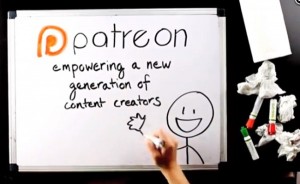 That’s right: we’re a series, which means you can check back with MathSP every month to learn about one of the coolest startups revolutionizing the way we live today. This month’s installment zeroes in on a startup that’s putting an end to the “struggling artist” archetype. Yes, you heard us. Patreon is singlehandedly making it possible for artists to thrive monetarily through their arts. Intrigued? Read on.
That’s right: we’re a series, which means you can check back with MathSP every month to learn about one of the coolest startups revolutionizing the way we live today. This month’s installment zeroes in on a startup that’s putting an end to the “struggling artist” archetype. Yes, you heard us. Patreon is singlehandedly making it possible for artists to thrive monetarily through their arts. Intrigued? Read on.
Name: Patreon
Slogan: N/A
What It Does: Taking a leaf out of 15th Century Florence and the Medici-esque patronage that made the Sistine Chapel possible, Patreon (pronounced Pate-ree-on) enables art appreciators to financially support the artists they love and empowers artists to make a living from their art. Sound like crowdfunding? It is, but with a twist: Patreon’s patrons pledge to support creators on a recurring basis for each work created, thereby empowering creators with a reliable source of income.
Funding: $17.1M to-date
Headquarters: San Francisco, CA
Founders: Sam Yam & Jack Conte
Founded: May 7, 2013
Main Competition: Subbable, Kickstarter, Paypal, YouTtube
How It Got Started: Before Jack Conte was a startup founder, he was a musician (indeed, even artists can enter the tech world and strike big). He worked 18-hour days for months at a time making YouTube music videos to promote songs produced by his band Pomplamoose. For all his hard work, he’d garnered almost a million YouTube hits but only a meager $200 in ad revenue. After working this financially strapped hustle for some time, he caught a great idea: to ask his fans to donate a few dollars for his next video. Within two weeks, they’d pledged over $4,000 and not just for a single video: they pledged this amount for every new YouTube video he produced. The enormous success of this idea catalyzed a light-bulb moment: he realized that his art wasn’t the reason why he wasn’t making money; it was the YouTube model he was using. So he called his freshman year roommate from Stanford, deft web developer Sam Yam, and together they innovated a platform for digital creators to secure reliable financial support from their fans.
How It Works: Fans pledge a certain amount of money every time a discernible piece of art is produced – an article, a chapter a serial work of fiction, a video. The average Patreon pledge is $7. For example, the “Postmodern Jukebox” video maker Scott Bradlee was Patreon’s top grosser last month because he puts out four videos each month and makes $3,757 per video and boasts 889 patrons. As reported by recode.net, the a cappella group Pentatonix brings in $12,000 per video, guaranteed. And then there’s Tom Merrit, a podcaster and daily tech news show hosts who has garnered 4074 patrons and brings in $11,188.19 each month.
The Artists: Many of Patreon’s creators are YouTube video makers; others are musicians, bloggers, comic strip artists, podcasters and writers. Artists on Patreon have one thing in common: fan bases that love them enough to guarantee recurring revenue.
The Competition: In late May of 2014, YouTube announced that it was finally going to address the growing numbers of YouTube content creators that are dissatisfied with the monetary compensation that they receive from the site. The solution: “Fan Funding,” a platform that looks undeniably similar to Patreon. Subbable, a startup that bills itself as a “new way to support the people who make the content you love,” is a subscription service that allows audiences to provide recurring payments to their beloved creators. Much like Patreon, Subbable connects creators to their audiences so that they can receive sustained financial support for their work.
The Revolution: Patreon is displacing the standard ad model, which rewards creators that garner the most views without factoring in the level of engagement that those views represent. By connecting content creators to their communities instead of to advertisers, Patreon is creating pathways for niche artists that don’t garner a million views to make a living off their art.
The Future: Patreon is angling to reinstate a patronage system that suits our modern life and has found some pretty big patrons of its own. And it’s no wonder either. In the words of founder Jack Conte, “We are succeeding because there are very few companies that actually cut creators a check at the end of each month. When creators learn about a service that PAYS them for making art, the adoption of that service is rapid and fervent.” Launched just over 14 months ago, Patreon already has a user base of 30,000 active patrons and 10,000 creators and enjoys 2 million page views per month.

